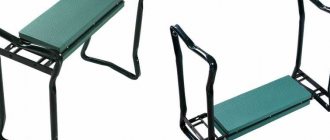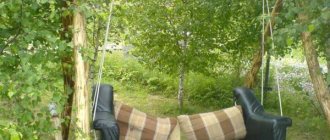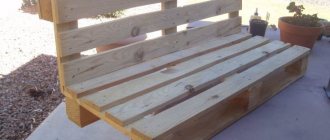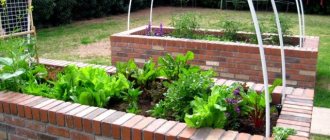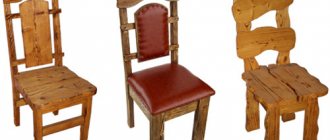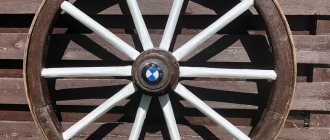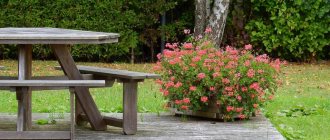Periodic gardening work is an obligatory part of the workday of owners of dachas and personal plots. But keeping the plantings pleasing to the eye clean and tidy is quite hard, tedious work. From being in a bent position for a long time, my lower back hurts and my legs hurt. And kneeling on the ground, which is not always flat and dry, is unpleasant. A universal bench for the garden will be an excellent assistant in this case - it’s quite simple to make a convenient “changeover” with your own hands, which will facilitate the processes of weeding, loosening and planting. Such products are very popular among gardeners, because with a minimum of labor and financial costs, they make it easier to care for the land, while ensuring a comfortable back position.
Design advantages
The design of such a bench is quite simple. The two supports on the sides are solid, stable legs that will not sink even into wet or loose soil. And the inverted bench turns into a comfortable soft knee rest or hand rest for working in the garden.
The product, designed to perform numerous manipulations with the soil in the country or in the garden, is surprisingly multifunctional. On it you can:
- sit and relax during a break between digging up beds;
- perform work accessible from a sitting position, sitting comfortably on a soft seat, reducing the load on the legs and back;
- turning it over, kneel on it if a painstaking task requires bending over the bed;
- rest your hands securely on the high side posts, then it will be immeasurably easier to rise from your knees if your legs are numb.
A DIY upside-down garden bench will become a reliable assistant when performing many activities. With its help, any work in the garden is greatly simplified, including:
- cleaning tree bark, filling cracks, whitewashing trunks and lower skeletal branches;
- weeding beds, picking up seedlings, planting plants in the ground, loosening, trimming strawberry tendrils;
- landscaping the territory, painting borders, low picket fences, caring for flowers in the flower bed;
- picking berries from bushes, sanitary pruning of low bushes, tying cucumbers and other climbing plants, pinching.
Simplicity of execution and wide scope of use determine the increasingly growing popularity of the chair for working in the garden. An inverted bench makes it much easier to carry out daily care of plants and the territory.
Inverted bench for garden beds (60*27*49 cm)
Seller's reliability: excellent!
Delivery within Russia: free!
Customer reviews:
Review #1: The seat simply folds and unfolds. At the same time, it looks quite durable with soft and dense material on both sides of the seat. It can be used in two ways: as a chair with legs, and by turning it over as a kneerest, using legs instead of handles. We will test it in the summer at the dacha. The product was packaged well and delivered by courier at the seller's expense.
Review No. 2: Ordered 5/10, received 3/11 (Tver region). Corresponds to the description, the seat is soft on both sides, I took it as a gift for a retired gardener, I hope I like it The order was sent quickly, thank you to the seller!!
Review #3: This is a great idea. I bought it in advance for the gardening season. Corresponds to the description! Thanks to the seller, everyone is happy!
Product dimensions
Having decided to make a bench with your own hands, you need to decide what dimensions are needed. A standard bench for a summer residence, without individual modifications, has the following dimensions:
- length – 60 cm;
- width – 30 cm;
- height of legs – 50 cm.
When creating an inverted garden bench with your own hands, you can approach the process creatively, changing the standard sizes according to your individual needs. For example, make the legs higher if the owner is tall and would find it uncomfortable to sit on a low chair. You can also lengthen or widen the seat, depending on the size of the person who will use the product, or for greater comfort. If the structure is assembled with your own hands from hollow tubes, then the main weight of the bench for working in the beds falls on the seat. In this case, it is quite possible to increase its size without significant weighting. Even if you add another 30 cm to the standard dimensions, the weight will remain virtually unchanged. If the garden inverted chair is made of wood or chipboard, any significant increase in size can affect the overall weight of the structure, which will make it inconvenient to carry and too bulky.
When determining the dimensions of a structure to create with your own hands, gardeners should consider what material it will be made from.
Knee pads
Probably the simplest and most budget option. They protect joints from cold, dampness and injury, making work more comfortable. The main thing is to choose a comfortable model so that it fits your feet, as they say. I haven't been able to find one yet, unfortunately. Although I would probably use the idea from the following short video.
A pocket for a knee pad on work trousers easily and elegantly solves the problem that for me personally has become the main obstacle to using these devices - the way they are attached: the straps put pressure on the leg, causing considerable discomfort and causing swelling. If you fix it too loosely, the structure simply slides.
Materials and tools
Without a doubt, every summer resident, home craftsman or simply zealous owner will have in stock cuttings of boards, thick plywood or the remains of polypropylene pipes. It is quite easy to find raw materials from which you can make a garden bench for weeding in the dacha farm, in exactly the proportions that are needed. Examples of materials that gardeners can use to make a bench with their own hands, the features of their influence on the final weight of the product, the pros and cons are presented in the table.
| Material | pros | Minuses | Weight |
| Wooden boards | Affordable, durable, and with proper care will last a long time | Wood is afraid of dampness and moisture, so there is a risk of swelling and rotting if used and stored improperly | Depends on the type of wood and the degree of dryness. Well-dried pine or linden boards are light, the wood is quite soft |
| Chipboard, plywood | No special skills required, just the simplest tool needed | Materials pick up moisture very quickly and swell. The plywood begins to delaminate, and the chipboard begins to crumble. Less durable than other options, capable of deformation from gravity | The heaviest materials that can be used to make a standard size high chair |
| Hollow polypropylene tubes | Easy to process, as a rule, trimmings remain from repairs or construction and do not require special conditions for operation | A plumbing soldering iron is required | The lightest material possible. You can create a bench of any size that is convenient, it will have little effect on the weight |
A universal garden bench is easy to make with your own hands, you just need to put in a little effort. In addition to the necessary raw materials, you will also need tools. Basically, you take what is at hand: a hand saw or a grinder, a jigsaw, a drill for drilling holes. To work with plastic tubes, you will need a hacksaw for metal, as well as a plumbing soldering iron.
When working with tools, you must protect your hands with gloves and your eyes with goggles to avoid injury.
Wooden boards
Plywood
Chipboard
Polypropylene pipes
Required Tools
Easy weeding: knee pads, rugs, chairs and other garden helpers
It depends on everyone, but the thing that gives me the most problems is weeding. I can’t squat; in the traditional “up-with-you-know-what” position it becomes more and more difficult over the years. There are two options left: either on your knees or sitting. Ideally, sitting not on a stool or chair from which you have to bend over (which is very uncomfortable and not particularly useful), but on the ground. But on earth it is cold and also not good for health at all. What should I do?
And this is also inconvenient, and even not particularly beneficial for health...
I’ll say right away: I know about mulching. About Fokin’s flat cutter too. But my friendship with the latter hasn’t worked out for years, and I haven’t gotten used to mulching all the plantings without exception yet. Everything has its time, I guess. In addition, the list of works in which one has to bow to the earth is not limited to weeding: there is also planting and harvesting crops (take strawberries, for example) - but you never know what a summer resident has to do...
Probably, knee pads would be very useful here.
Therefore, this time we are going in search of convenient and affordable devices that make “classic” care of garden beds easier. We’ll postpone the “instrumental question” until the next article, but for now let’s see what devices can be used to solve the problem of bowing to the ground during dacha work without harming your health.
How to make it yourself
The process of making a bench for weeding beds will not take much time. First you need to decide on the materials. Then you can begin the labor process. To make a simple wooden bench you will need:
- boards 15-25 mm thick;
- jigsaw for cutting holes;
- drill;
- sandpaper for polishing;
- furniture wooden pins;
- wood glue;
- oilcloth fabric;
- soft material such as foam rubber.
Two trapezoidal legs are cut out from boards of suitable width with a difference between the upper and lower parts of about 10 centimeters. For example, the top element can be 25 cm wide, the bottom - 38. If the width of the boards is not enough, the sidewall parts will have to be additionally attached to the transverse strips at the top and bottom. The height of the sidewalls is usually 50 cm and above. Work algorithm:
- Cut the seat width slightly narrower than the upper end of the sides. The length is arbitrary - usually fifty centimeters.
- Cut recesses one centimeter deep exactly in the middle of the upper and lower parts of the sidewalls, leaving five centimeters from the edges.
- If desired, cut oval holes for ease of carrying and operation - in the central part of the seat and the wide lower parts of the sides.
- In order to fasten the seat and sidewalls, drill holes for the pins: four in the narrow ends of the seat and four in the sidewalls. This must be done so that the seat does not reach the edges of the narrow sidewalls by 8-10 centimeters.
- Drive the pins into the holes, coat them well with glue, and connect them to the sidewalls.
- To avoid getting on your knees too hard, cut a mattress out of cushioning material to fit the size of the seat, with a hole in the middle corresponding to the one on the seat, and then cover it with non-marking oilcloth fabric. You can make the mattress double (top and bottom) or removable so that you can wash it.
You can also build a bench for weeding beds from small boards of hard wood. In this case, instead of a solid seat and sides, the structure is assembled from separate slats. A stool made with your own hands should be carefully varnished or painted to protect it from exposure to dampness, dirt and insects.
For a better understanding of how to make a weeding chair with your own hands, it is worth first studying the diagrams and design drawings presented on numerous thematic sites.
Cut two trapezoidal legs
Make holes for ease of carrying and operation
Drill holes for pins
Make holes in the sides
Drive in the pins, coated with glue, and connect to the sidewalls
Finished bench
To make a high chair from polypropylene tubes, you will need:
- polypropylene pipes, 32 mm in diameter - four meters;
- ninety-degree corner of the same diameter - 8 pieces;
- tees for a diameter of 32 mm – 8 pieces;
- plumbing soldering iron;
- hacksaw for metal;
- plywood for seat;
- soft backing material.
First you will need to cut the pipes with a hacksaw according to this pattern:
- 24 cm – six pieces;
- 14.5 cm – six pieces;
- 34.5 cm – four pieces;
- 3 cm - four pieces.
Solder the middle from two pieces of 24 cm and six pieces of 14.5 cm. Then solder the upper handrails-legs to it, from two tubes of 24 cm, and then the sidewalls - 34.5 cm each, and the lower handrails-legs. Screw cut-to-size plywood onto the bottom and top. For softness, you can sew or glue any porous material onto it.
The final dimensions of the product made according to the above instructions will be:
- height – 49 cm;
- length – 60 cm;
- width – 33 cm;
- weight – 5.5 kg.
This simple design has a number of advantages: it is lightweight, does not require special storage conditions, painting, and is not subject to corrosion and rotting. If necessary, the dimensions of a universal bench for a vegetable garden with your own hands can be changed at will without compromising the strength or weight of the product.
Homemade bench for gardening work
Hello to DIYers, as well as summer residents and gardeners!
When carrying out many types of gardening work, you have to bend down a lot and stay in this position for quite a long time. This, for example, includes work such as sowing seeds, weeding beds, picking strawberries, etc.
Naturally, doing this type of work while standing is very inconvenient and simply harmful, especially for the spine. It is much better and more convenient to do such work while sitting on a small bench.
Such a bench must satisfy two main requirements: firstly, it must be low enough so that it is convenient to reach the ground from it, and secondly, it must be light enough so that it can be carried comfortably.
Therefore, today I will tell you how you can make a very simple version of such a bench. Moreover, this is perhaps the simplest design of such a bench that can be.
It consists of only four parts that can be cut from a single board. The main thing is that the board is wide enough, at least 20 cm wide. Although, in order to save a wide board, for the manufacture of one of the parts (legs or lintels), I will take a narrower board.
Thus, to make a bench we will need the following accessories:
Materials and fasteners:
A piece of board 2 cm thick, 20 cm wide, and 110-120 cm long.
A small piece of board 2 cm thick, 15 cm wide, and 40 cm long.
Ten wood screws 4x80 mm.
Paint for wood.
Drawing and measuring tools (pencil, tape measure and square).
A jigsaw with a file for curved cutting.
Manual router with a set of cutters.
Metal drill with a diameter of 4 mm.
Spherical cutter for wood.
Screwdriver bit RN2, for driving screws.
Additional equipment
For ease of use, the bench can be equipped with various useful little things. Here imagination and consideration of personal needs will come to the rescue:
- to make it convenient to use the product for processing beds, for example, when you need to kneel down, weed or loosen plantings and trim plants, a variety of cushion seats are suitable;
- a foam rubber mat wrapped in oilcloth can be attached to both sides of the seat to make sitting and kneeling softer; to make it easier to wash soiled material, it is better to make it removable, for example, in the form of a pad with ties;
- on the sides you can attach fabric pockets with valves for small equipment or water bottles;
- For carrying, you can build a shoulder strap that allows you to free your hands.
To soften the seat mat, pieces of tourist foam, synthetic padding, polystyrene, holofiber, struttofiber, and other synthetic padding materials can be used.
As you can see, the simplicity of the design will make it easy to create a “shifter” yourself. Such a homemade weeding chair will remain a useful and necessary household device for a long time, and its use in the garden will help save strength and health.
This weeding bench on wheels is a godsend!
Seller's reliability: excellent!
Delivery within Russia: free!
Customer reviews:
Review #1: I decided to order this miracle dacha. I waited 3 weeks. The bench came on wheels. They are big. It is comfortable to sit and move without effort))).
Review No. 2: Miracle find from Aliexpress. I will test it this season. Rather))).The envy of the neighbors.
Review #3: The bench has wheels and is easy to maneuver. He rides forward and backward, as if in a saddle. Seems stable. The children even tried to drive it))). Super purchase. Nothing was damaged during delivery.
